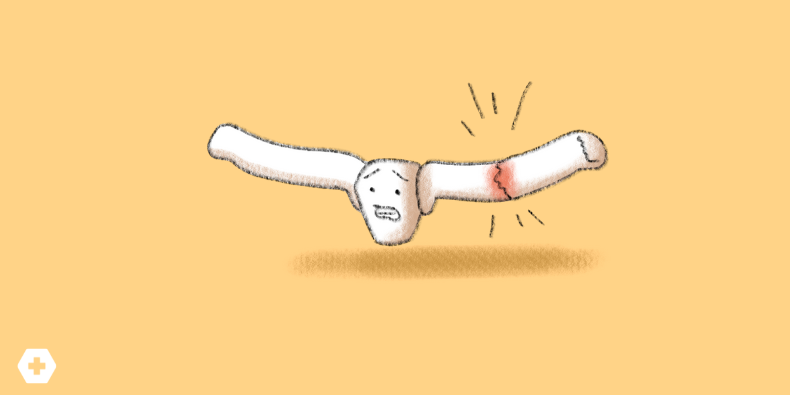
Managing Clavicle Fractures in Urgent Care

Clavicle fractures are among the most common orthopedic injuries that we encounter in the Urgent Care setting. That makes them the perfect topic for a quick review!
The vast majority of clavicle fractures can be managed definitely by urgent care clinicians, but there are a few sneaky times when the patient may need emergent orthopedic evaluation.
Thinking Anatomically: The Rule of Thirds
Dividing the clavicle into medial, middle, and lateral thirds provides a practical framework for assessment and management:
- Middle-third fractures: The most common, accounting for nearly 70% of clavicle fractures. In pediatric patients, this number jumps to 90%.
- Lateral-third fractures: Less common but often mistaken for acromioclavicular (AC) joint separations.
- Medial-third fractures: The least common (about 2%) but the most concerning due to their association with severe trauma.
Mechanism Matters
Understanding how the injury occurred is crucial:
- Falls onto the shoulder are the most common cause of clavicle fractures.
- High-speed motor vehicle collisions (MVCs) raise suspicion for polytrauma.
- Low-impact falls, like a simple bicycle tip-over, are less concerning but still warrant evaluation.
Diagnostic Imaging
Plain radiographs remain the primary imaging modality:
- AP view: Often sufficient for middle-third fractures.
- Cephalic tilt view: Useful if an AP view does not clearly demonstrate the fracture.
- PA chest film: Can help compare clavicular lengths to detect subtle injuries.
Associated Injuries to Consider
The location of the clavicle fracture guides concern for associated injuries:
- Middle-third fractures: Check for scapular, rib, and sternal fractures.
- Lateral-third fractures: Consider AC joint injuries and possible "floating shoulder" (clavicle and glenoid neck fractures together, requiring urgent orthopedic evaluation).
- Medial-third fractures: These should set off alarm bells—80% result from MVCs, and 90% involve multisystem trauma. High mortality is associated with these injuries, warranting thorough assessment.
When to Refer for Surgical Evaluation
Send patients for immediate orthopedic evaluation if you see:
- Open fractures
- Neurovascular compromise
- Skin tenting (discoloration of skin suggested threatened perfusion over the injury)
- Severe displacement, comminution, or significant shortening
Any patient with respiratory distress or hemodynamic instability requires urgent stabilization and transfer to a trauma-capable facility.
Fracture Patterns of Lateral-Third Clavicle Injuries
Distal clavicle fractures can be subtle and difficult to distinguish from AC separations. They are classified into three types:
- Type 1: Non-displaced, ligaments intact.
- Type 2: Ligamentous disruption with displacement.
- Type 3: Intra-articular fractures extending into the AC joint.
Medial-Third Clavicle Injuries: Red Flags
Medial clavicle fractures demand heightened vigilance due to their strong association with severe trauma. Key considerations:
- MVCs cause 80% of these injuries.
- 90% involve multisystem trauma, with a 20% one-month mortality rate.
- For atraumatic cases (e.g., repetitive stress fractures from sports like gymnastics or rowing), conservative management with a sling, ice, NSAIDs, and rest is appropriate.
Management of Uncomplicated Middle-Third Clavicle Fractures
For standard, non-displaced middle-third clavicle fractures, initial management focuses on pain control and immobilization:
- Sling vs. Figure-8 Bandage: Evidence shows similar outcomes, but slings are generally more comfortable.
- Ice and NSAIDs: Help manage pain and swelling.
- Follow-Up: Recommended within 1-2 weeks. Most primary care physicians will be comfortable managing this and these patients do not necessarily need orthopedic follow up.
Top Take-Home Points
- Think anatomically: Divide the clavicle into medial, middle, and lateral thirds to guide management.
- Medial-third fractures are rare but serious: High suspicion for multisystem trauma is warranted.
- Immediate ortho referral for red flags: Open fractures, skin tenting, or neurovascular compromise demand emergent evaluation.
- Most clavicle fractures are treated nonoperatively: Sling, ice, and pain control are the first-line management strategies.
Practice-Changing Education
Experience education that goes beyond theory. Explore Hippo Education’s offerings below.

